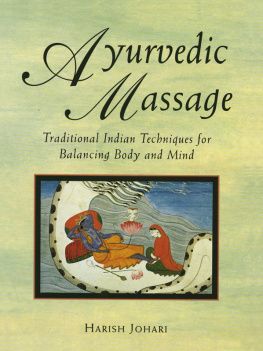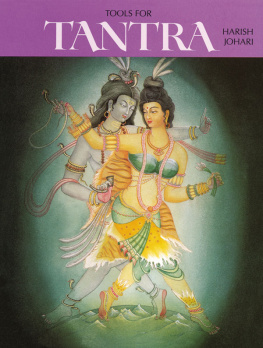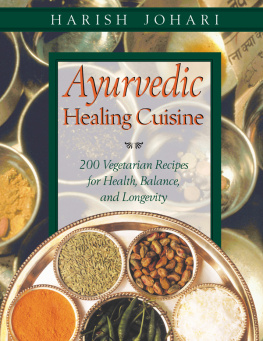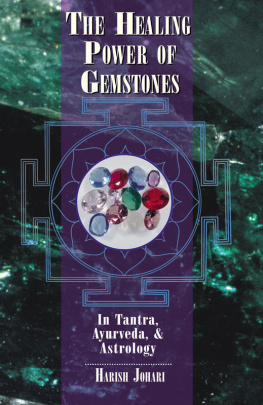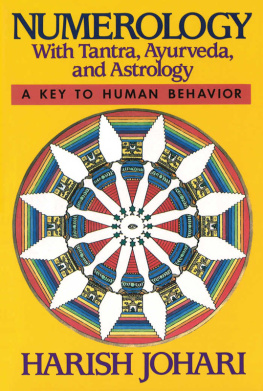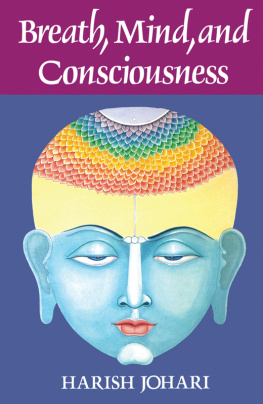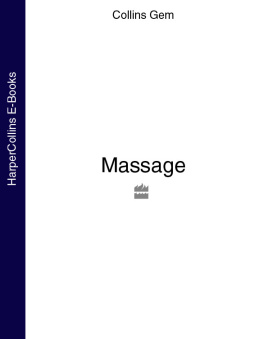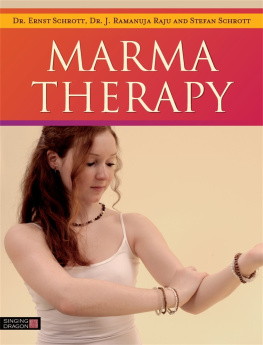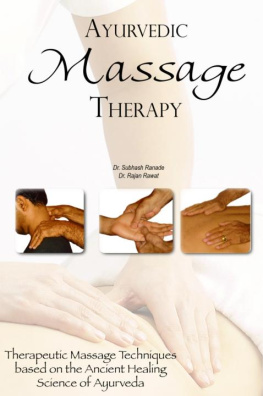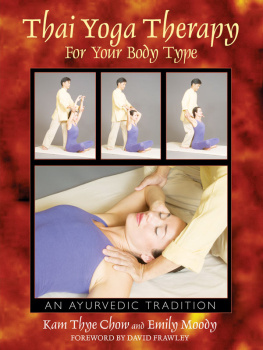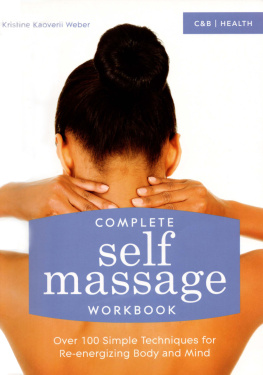Ayurvedic Massage
Traditional Indian Techniques for Balancing Body and Mind
HARISH JOHARI
Illustrations by
PlETER WELTEVREDE

Healing Arts Press
Rochester, Vermont
Preface
My training in Ayurveda started at an early age. As a child of eight or ten, I would assist my mother in making powdered herbal remedies, healing poultices, face masks, and herbal teas. Later on I would assist my grandfather and granduncle in making eye remedies, oxides and pastes from gemstones, and rejuvenating tonics (rasayanas).
Between the years 1955 and 1968 I was in the constant company of an Ayurvedic practitioner, a vaidya, by the name of Rameshwar Prasad Pande. During this period, 1 learned about the healing energy of foods, herbs, plants, and gemstones; the doshas or body humors; the role of astrology in understanding illness (both physical and mental); and how to detect disease by examining various parts of the body. My interest in Tantric yoga and alchemy brought me to meet many vaidyas, and each of them taught me something valuable about life.
At the age of thirteen 1 became a regular practitioner of wrestling. At the martial arts school, or akhara, in Jaunpur I met many vaidyas who practiced wrestling for their own physical and mental well-being. Wrestlers in India could be called the artists of bodyworkthey work with prana, pranic energy, breath control, and various exercises to build strength, stamina, and vigor. Massage was an integral part of wrestling.
In ancient times Ayurvedic clinics did not regularly offer massage, as everybody gave and received massage. Whenever patients needed a particular treatment they were referred by vaidyas to massage specialists. These technicians used special oils and rubbed the afflicted areas as instructed by the Ayurvedic doctor. Often these massage practitioners were wrestlers. Today in India massage practitioners with this training roam public places in great number and give head and body massages for a few rupees. Although they may have no knowledge of Ayurveda, they do know how to work with muscles, joints, and bones. One of my trainers was the famous wrestler Siddique Khan, from Nawab of Rampur. He was a perfected master of massage who could heal and strengthen any body part, tissue, or muscle.
Some of these wrestlers/massage practitioners were also Ayurvedic doctors and/or hakims. (A hakim is a doctor who has studied the Unani [Greek] system of medicine.) Over time they developed a special system of their own that contained the knowledge of the Ayurvedic or Unani system of medicine. The massage methods described in this book are based on the techniques of these doctor/wrestlers. I call it traditional Indian massage based on Ayurvedic principles, such as the doshas and marmas (pressure points). Over the years I have trained with two main groups of teachers, one Hindu and the other Muslim. From the Hindu teachers 1 learned about marmas and doshas; from the Muslims I learned about pressure points called muqame makhsoos. Much of the time the marmas and the muqame makhsoos are the same, but there are occasional important and helpful differences. Some of the pressure points on the feet correspond to those used in the West by reflexologists.
The massage presented in this book is primarily preventive and is to be practiced on a regular basis for this purpose. Except for dealing with some minor ailments, this massage method is not meant to be therapeutic. It is not, for example, the same as the massage given before panchakarma (purification) treatments. Many therapeutic Ayurvedic methods use oils and techniques specific to a particular disease condition. These methods should be practiced only under the supervision of an Ayurvedic doctor or vaidya, and they are not covered in this book.

I thank my guides, teachers, and students who helped me create this book. I hope it will be of some practical use to those interested in improving their mental and physical well-being.
Introduction
M ans strongest desire is to live a healthy, happy, and inspired life. Of these three, health is primary because without it one cannot feel happy or inspired. One of the keys to good health is having a body that circulates nutrients properly and expels toxins efficiently. Food provides us with the proper nutrients, exercise and massage supply the proper circulation, and massage helps our bodies grow and renew. Massage also provides relaxation. By enhancing the circulation of nutrient material and helping the organism expel toxins, massage plays an important role in cleansing and maintaining the health of the body. This cleansing role is what makes massage a most beneficial practice for achieving inspiration and joy. It excites the bodys internal resources, stimulating it to process protein, convert various forms of sugar into glucose, and generate various chemical enzymes. If adopted as a daily practice, massage can help rejuvenate the body.
In India massages are given from the time of birth. Babies are regularly massaged with oil, even when they cry. A mother knows that massage will enhance circulation in her infant, who, although continually moving, is unable to perform exercises of any kind. Children are massaged regularly each day until the age of three. Then the routine changes and massage is given once or twice a week, until the child reaches six years of age. At this point, the child is old enough to give and exchange massages with others.
Eighty percent of the population in India live in villages where this tradition is still alive. In rural areas, weekly massage is a family sceneeveryone does it. With the hectic pace of life in large towns and cities, it is becoming increasingly difficult to maintain this tradition. However, even in big cities like Delhi, Bombay, and Calcutta, a massage man can often be seen with his mat and a rack of small oil bottles practicing his trade in the park or on the beach. People in India enjoy being massaged; they know that, like a best friend, it brings joy and relaxation.
In India, temple sculptures, calendars, and illustrated spiritual books often depict Vishnu, the lord of preservation, reclining on a serpent and receiving a foot massage from his consort Lakshmi. This image suggests that massage is a favorite pastime even of Lord Vishnu.
In the Indian home, massage can help maintain a loving relationship between husband and wife. After this kind of soothing relaxation, it is easier to share and give more love. Coming home from a long day of work in the outside world, the husband can often be found receiving a loving massage from his wife. This type of massage is not usually done with oilthe muscles are just gently squeezed and rubbed. Even the older family members receive a form of massage as grandchildren press against their bodies in play.
Ceremonial massages are also practiced in India. Massage before marriage is one of the few ceremonial massages in the Hindu tradition that is compulsory even today. This is because it lends a glow to the skin and relaxes the couple, making them look fresh and shiny. For the groom, the massage can also provide an increase in virility and psychic strength. Because the massage is done with natural herbs and oils, it makes the bride more fragrant and beautiful.
Another traditionally compulsory massage is the one given daily to the new mother during the forty days following birth. Traditionally this is the time for a womans complete body purification, after which she can return to performing her daily worship or household chores.
Next page
